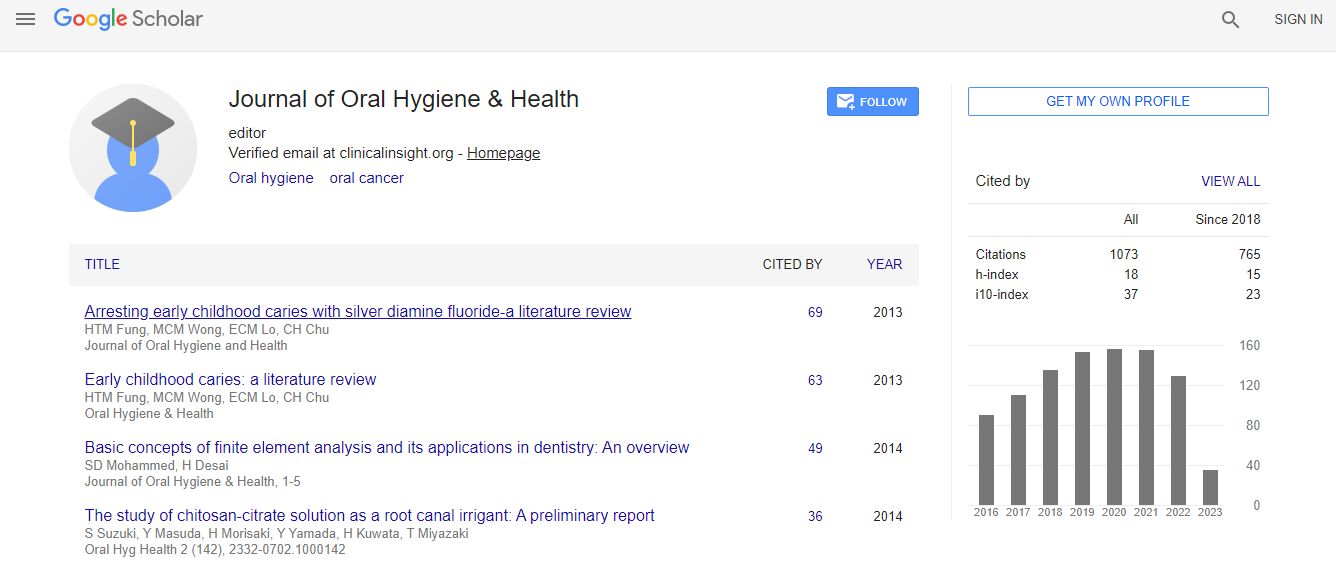Our Group organises 3000+ Global Conferenceseries Events every year across USA, Europe & Asia with support from 1000 more scientific Societies and Publishes 700+ Open Access Journals which contains over 50000 eminent personalities, reputed scientists as editorial board members.
Open Access Journals gaining more Readers and Citations
700 Journals and 15,000,000 Readers Each Journal is getting 25,000+ Readers
Google Scholar citation report
Citations : 1073
Journal of Oral Hygiene & Health received 1073 citations as per Google Scholar report
Journal of Oral Hygiene & Health peer review process verified at publons
Indexed In
- Index Copernicus
- Google Scholar
- Open J Gate
- JournalTOCs
- RefSeek
- Hamdard University
- EBSCO A-Z
- OCLC- WorldCat
- Publons
- Geneva Foundation for Medical Education and Research
- Euro Pub
- ICMJE
Useful Links
Recommended Journals
Related Subjects
Share This Page
Formulation of a chewing gum for treating oral candidiasis
2nd International Conference on Restorative Dentistry and Prosthodontics
Jones Ozokwere, Eugene Olivier, Mulamba Gedeon and Patrick Demana
Tshwane University of Technology, South Africa University of Limpopo, South Africa
ScientificTracks Abstracts: J Oral Hyg Health
Abstract
Fungal infections have become major causes of morbidity and mortality among immuno-compromised patients. Oral candidiasis is a fungal infection caused the opportunistic pathogen named Candida albicans. Conventional available treatments for oral candidiasis include topical antifungal azoles such as Miconazole, Amphotericin B and Nystatin. Miconazole, in various formulations (gels, lozenges or mixtures) for local application, is an effective antimycotic drug for treating oral candidiasis. However the increase of resistant micro-organisms to conventional treatment is becoming a challenge, researchers are trying to identify potential drugs and alternatives treatments with better and improved therapeutic effects and fewer adverse effects. Essential oils have been used for the treatment of several diseases. They possess antibacterial, antifungal, antiviral and antiseptic activities. Certain essential oils have been shown to have antifungal activity or reduce the risk of fungal infections. In this study, a selection of essential oils was made and evaluated based on their anti-candidal activity, organoleptic properties, availability and minimum inhibitory concentration for possible inclusion and formulation into the chewing gum as an active pharmaceutical ingredient. Preformulation studies were conducted to identify suitable excipients and evaluate physicochemical compatibilities of the actives with selected excipients. From three placebo formulations obtained from the gum base manufacturer, preliminary development of the formulation was done. A series of formulations were developed by varying different tablet components. The active pharmaceutical ingredients (API��?s) were included in the gum core both at 2% (w/w) of the MCG composition. The formula was subjected to scale-up. Produced MCG��?s from the scale-up were film coated to improve stability. Finished products were subjected to post-compression evaluation including in vitro release of the API��?s from the dosage form. This study proved that it is possible to develop a medicated chewing gum with a combination of essential oils as active substances for the effective treatment of oral candidiasis.Biography
Email: jocs_scoj@yahoo.com

 Spanish
Spanish  Chinese
Chinese  Russian
Russian  German
German  French
French  Japanese
Japanese  Portuguese
Portuguese  Hindi
Hindi 
